Lab 8.4.1 – Media Connectors Lab Activity (Answers)
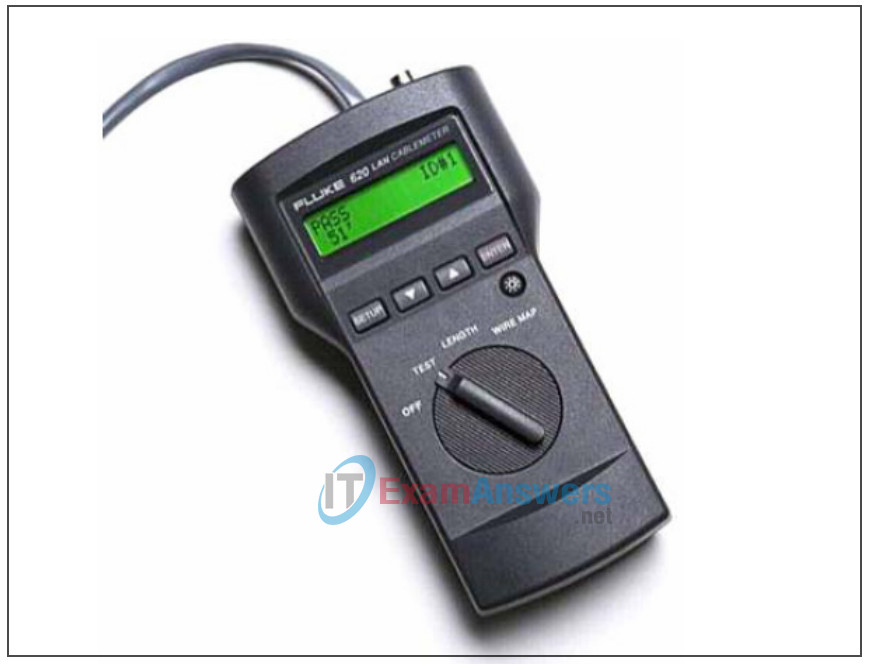
Fluke 620 LAN CableMeter
Learning Objectives
Upon completion of this lab, you will be able to:
- Test cables using a Fluke620 LAN CableMeter and a Fluke LinkRunner
- Become familiar with the most common functions of a cable tester.
- Test different cables for type and wiring problems.
Background
Category (CAT 5) unshielded twisted-pair (UTP) cables are wired according to function. End devices, such as routers and host computers, connect to switches with CAT 5 straight-through cables. When connected together, however, a CAT 5 crossover cable must be used. This is also true of switches. When connecting one switch to another, a CAT 5 crossover cable is used again.
Problems related to cables are one of the most common causes of network failure. Basic cable tests can be very helpful in troubleshooting cabling problems with UTP. The quality of cabling components used, the routing and installation of the cable, and quality of the connector terminations will be the main factors in determining how trouble-free the cabling will be.
Note to Instructor: Prior to starting the lab, the teacher or lab assistant should have several correctly wired CAT 5 cables that are used by the student to learn cable tester operation. The cables should be both straight-through and crossover. There should also be several CAT 5 cables available with problems. Cables should be numbered to simplify the testing process and to maintain consistency.
The following resources are required:
- Good CAT 5 straight-through and crossover wired cables of different colors.
- Category 5 straight-through and crossover wired cables with open wire connections in the middle or one or more conductors shorted at one end that are different colors and different lengths.
- Fluke 620 LAN CableMeter or equivalent.
- Fluke LinkRunner
TIA/EIA 568B is different from TIA/EIA 568A wiring. TIA/EIA 568A straight-through cables can be identified by the color coding. Similar to Figure 2, below, the right wiring diagram, starting with the green-white cable, will be identical on both ends.
Scenario
First, you will visually determine whether the CAT 5 cable type is crossover or straight-through. Next, you will use the cable tester to verify the cable type, as well as common features available with the tester.
Finally, you will use the cable tester to test for bad cables that cannot be determined with a visual inspection.
Task 1: Become Familiar with the Most Common Functions of a Cable Tester.
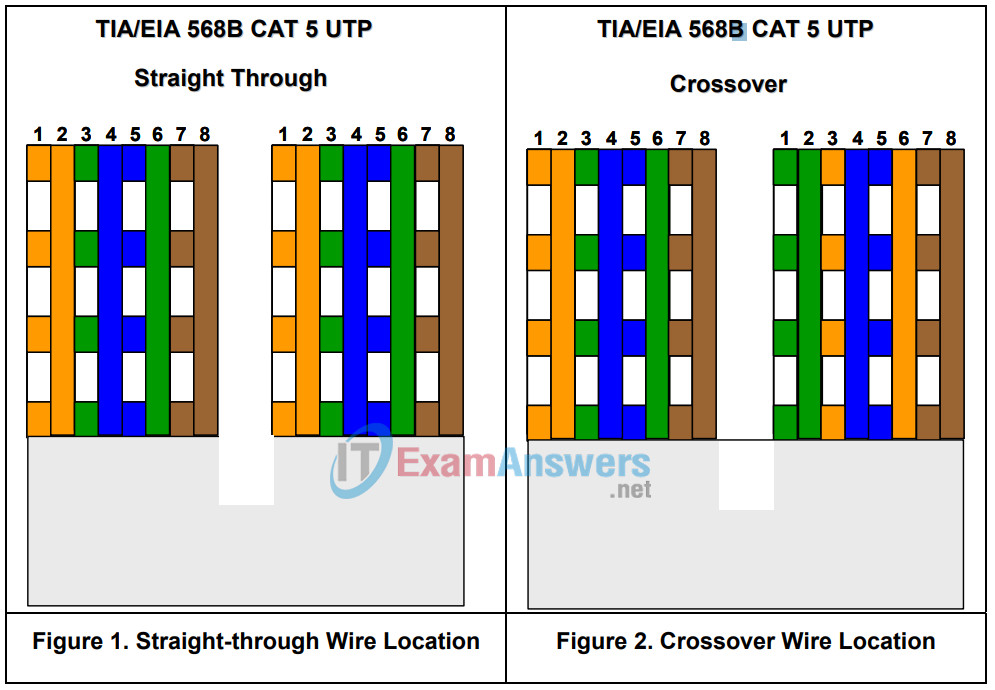
Figures 1 and 2 show the TIA/EIA 568B CAT 5 UTP wire positioning for a straight-through and crossover cable, respectively. When CAT 5 connectors are held together, wire color is a quick way to determine the cable type.
Step 1: Visually determine cable types.
Note to Instructor: Students should be given a functional straight-through and crossover cable. These cables will be used to learn cable tester features and build confidence in cable tester accuracy.
There should be two numbered cables available. Perform a visual inspection of the cables and then fill out the chart below with the cable color, cable type, and use:
| Cable No. | Cable Color | Cable Type (straight-through or crossover) |
Cable Use (Circle correct device) |
|---|---|---|---|
| 1 | Answers will vary | Answers will vary | Switch to: host / switch |
| 2 | Answers will vary | Answers will vary | Switch to: host / switch |
It is now time to verify the cable type and learn about the common features of the cable tester.
Step 2: Perform initial configuration of the Fluke 620 LAN CableMeter.
Turn the rotary switch selector on the tester to the WIRE MAP position. The wire map function displays which pins on one end of the cable are connected to which pins on the other end.
Press the SETUP button to enter the setup mode, and observe the LCD screen on the tester. The first option should be CABLE. Press the UP or DOWN arrow buttons until the desired cable type of UTP is selected. Press ENTER to accept that setting and go to the next one. Continue pressing the UP/DOWN arrows and pressing ENTER until the tester is set to the following cabling settings:
| Tester Option | Desired Setting – UTP |
|---|---|
| CABLE: | UTP |
| WIRING: | 10BASE-T or EIA/TIA 4PR |
| CATEGORY: | CATEGORY 5 |
| WIRE SIZE | AWG 24 |
| CAL to CABLE? | NO |
| BEEPING: | ON or OFF |
| LCD CONTRAST | From 1 through 10 (brightest) |
When satisfied with the correct settings, press the SETUP button to exit setup mode.
Step 3: Verify cable wire map.

Figure 3. Cable Coupler and Cable Identifier
Use the following procedure to test each cable with the LAN cable coupler and cable identifier, shown in Figure 3. The coupler and the cable identifier are accessories that come with the Fluke 620 LAN CableMeter.
Place the near end of the cable into the RJ-45 jack labeled UTP/FTP on the tester. Place the RJ-45-RJ-45 female coupler on the far end of the cable, and then insert the cable identifier into the other side of the coupler.
The wiring of both the near and far end of the cable will be displayed. The top set of numbers displayed on the LCD screen refers to the near end, and the bottom set of numbers refers to the far end.
Perform a Wire Map test on each of the cables provided, and fill in the following table based on the results. For each cable, write down the number and color, and whether the cable is straight-through or crossover.
| Cable No. | Cable Color | Cable Type (straight-through or crossover) |
|---|---|---|
| 1 | Answers will vary | Answers will vary |
| 2 | Answers will vary | Answers will vary |
Note any problems encountered during this test:
Step 4: Verify cable length.
Move the rotary switch selector on the tester to the LENGTH position. If power was cycled, repeat the setup steps described in Step 2. The tester LENGTH function displays the length of the cable.
Perform a basic cable test on each of the cables, and complete the following table based on the results. For each cable, write down the number and color, the cable length, the tester screen test results, and what the problem is, if there is a problem.
| Cable No. | Cable Color | Cable Length |
|---|---|---|
| 1 | Answers will vary | Answers will vary |
| 2 | Answers will vary | Answers will vary |
Note any problems encountered during this test:
Answers will vary.
Repeat these steps until you are comfortable with the use of the cable tester. In the next task, unknown cables will be tested.
Task 2: Test Different Cables for Type and Wiring Problems.
Obtain at least 5 different cables from your instructor. Move the rotary switch selector on the tester to the WIRE MAP position. If power was cycled, repeat the setup steps described in Task 1, Step 2.
Using the cable tester WIRE MAP function, perform a Wire Map test on each of the cables provided. Then fill in the following table based on the result for each Category 5 cable tested. For each cable, write down the number and color, whether the cable is straight-through or crossover, the tester screen test results, and any problem.
| Cable No. | Cable Type (Visual inspection) |
Cable Color | Cable type (straight-through or crossover) |
* Test Results | Problem Description |
|---|---|---|---|---|---|
| 1 | Answers will vary. | Answers will vary. | straight-through | Top: 12364578 Bot: 12364578 |
None. |
| 2 | Answers will vary. | Answers will vary. | crossover | Top: 12364578 Bot: 36124578 |
None. |
| 3 | Answers will vary. | Answers will vary. | crossover | Top: 12oo4578 Bot: 36124578 |
Pins 3 and 6 are open somewhere in the first half of the cable |
| 4 | Answers will vary. | Answers will vary. | straight-through | Top: 12364578 Bot: 12364s78 |
Pin 5 is shorted in the last half of the cable |
| 5 | Answers will vary. | Answers will vary. | straight-through | Top: 12365478 Bot: 12364578 |
Miswire |
* Refer to the Fluke manual for detailed description of test results for wire map.
Answers are examples only, and will vary. Rows 3, 4, and 5 show examples of cable problems.
Task 3: Perform initial configuration of the Fluke LinkRunner
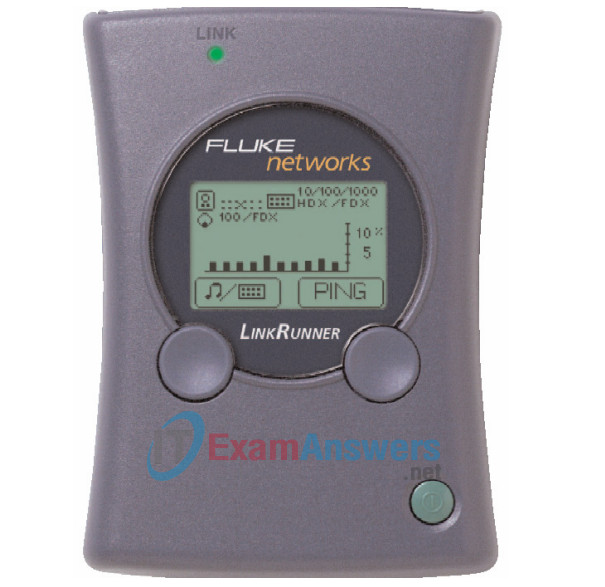
Fluke LinkRunner
Step 1: Turn the Fluke LinkRunner on by pressing the green button on the lower right along with the blue button on the right.
Step 2: Press the green button on the lower right to turn it back off.
Step 3: Place both ends of the cable into the LAN and MAP ports located on top of the LinkRunner and press the green botton on the lower right along with the blue button to the left.
If it is a correct straight-through cable then two parallel lines (as shown below) will appear on the upper left corner on the screen.
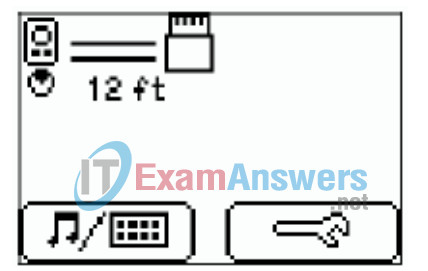
If it is a correct crossover cable then two intersecting lines (as shown below) will appear on the upper left corner on the screen.
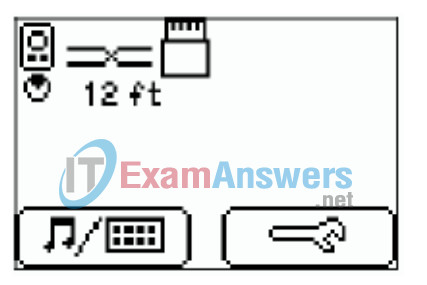
If it is a bad cable,
 will appear and details will be displayed below.
will appear and details will be displayed below.
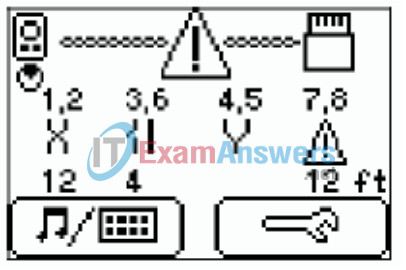
Task 4: Verify Cable Length
Note: The instructions to test a cable are the same as determining cable length. 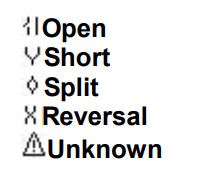
Task 4: Verify Cable Length
Note: The instructions to test a cable are the same as determining cable length.
Step 1: Turn the Fluke LinkRunner on by pressing the green button on the lower right along with the blue button on the right.
Step 2: Press the green button on the lower right to turn it back off.
Step 3: Place both ends of the cable into the LAN and MAP ports located on top of the LinkRunner and press the green botton on the lower right along with the blue button to the left.
Step 4: Locate the length of the cable below the icon indicating the type of cable (as shown below).
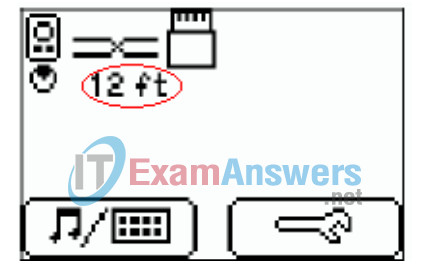
Task 5: Reflection
Problems related to cables are one of the most common causes of network failure. Network technicians should be able to determine when to use CAT 5 UTP straight-through and crossover cables.
A cable tester is used to determine cable type, length, and wire map. In a lab environment, cables are constantly moved and reconnected. A properly functioning cable today may be broken tomorrow. This isn’t unusual, and is part of the learning process.
Task 6: Challenge
Look for opportunities to test other cables with the Fluke 620 LAN CableMeter. Skills learned in this lab will enable you to quickly troubleshoot wrong cable types and broken cables.
Task 7: Clean Up
The cable tester is very expensive and should never be left unattended. Return the cable tester to the instructor when finished.
Ask the instructor where to return used cables. Store the cables neatly for the next class.
